
Chemical and Synthetic Biology: the Nano-Biotechnology Group
Gentle non-disturbing modification and manipulation of cellular proteins remain a major challenge in modern life sciences and medicine. Therefore, the Nano-biotechnology group combines interdisciplinary cutting edge techniques of chemistry, biophysics and molecular biology on nanometer dimensions. Our toolbox comprises: (i) semisynthetic peptides, (ii) photo-activatable protein dimerization and receptor clustering elements, (iii) two-photon activatable labeling pairs for precise and sensitive super resolution microscopy, (iv) semi-synthetic photo conditional viral inhibitorsfor spatio-temporal control of antigen processing, (v) genetic code expansion via photo-caged unnatural amino acids, and (vi) high throughput techniques for multiplexed single-transporter recordings. Furthermore, we work on a new tool to precisely control peptide-membrane interactions by photosensitive synthetic peptides.
Targets of our technologies address all functional dimensions of living cells. The application and optimization of minimal lock-and-key elements with spatio-temporal control are of high demand to connect protein activity with cellular response. These toolboxes allow us to perform 2D/3D multi protein patterning by one and two photon activation, precise intracellular live-cell labeling, protein dimerization, in-situ assemby of receptor complexes and thus exert control over signaling networks by light. Furthermore, live cell delivery techniques were utilized to obtain spatio-temporal control of antigen processing by synthetic viral inhibitors, which will open up new perspectives of fundamental cell biological pathways. Additionally, established highly parallelized imaging techniques based on transparent nanochips in combination with synthetic model membranes enable the multiplexed visualization of single biological or artificial nanopore kinetics.
The combined advantages will open up new opportunities to investigate relevant questions of cell biology in ways previously not possible.
Super-Chelators for Advanced Protein Labeling in Living Cells
Live-cell labeling, super-resolution microscopy, single-molecule applications, protein localization, or chemically induced assembly are emerging approaches, which require specific and very small interaction pairs. The minimal disturbance of protein function is essential to derive unbiased insights into cellular processes. Herein, we define a new class of hexavalent N-nitrilotriacetic acid (hexaNTA) chelators, displaying the highest affinity and stability of all NTA-based small interaction pairs described so far. Coupled to bright organic fluorophores with fine-tuned photophysical properties, the super-chelator probes were delivered into human cells by chemically gated nanopores. These super-chelators permit kinetic profiling, multiplexed labeling of His6- and His12- tagged proteins as well as single-molecule-based super-resolution imaging.
Click here to read the full story.

Ultrafast in-gel Detection by Fluorescent Super-chelator Probes with HisQuick-PAGE
Fluorescent probes based on Ni(II)-loaded super-chelator hexavalent N-nitriloacetic acid (hexaNTAfluorophore) are versatile, reversible and non-disturbing tools for fluorescent live-cell labeling of intracellular histidine-tagged proteins and in-situ imaging by super-resolution microscopy. Fluorescent multivalent chelator probes may also offer specific and stable labeling for convenient ultrafast protein detection in polyacrylamide gel electrophoresis (PAGE). We have reported on various in-gel fluorescence methods summarized as HisQuick-PAGE (Quick His-tag detection) as a fast and versatile immunoblot alternative, using such high affinity fluorescent super-chelator probes. The procedure allows direct, fast and ultrasensitive in-gel detection and analysis of His-tagged soluble proteins as well as intact membrane protein complexes and macromolecular ribonucleoprotein particles.
Click here to learn more.
Synthetic Protein-conductive Membrane Nanopores built with DNA
Nanopores are key in portable sequencing and research given their ability to transport elongated DNA or small bioactive molecules through narrow transmembrane channels. We have reported on a DNA nanopore capable of transporting folded proteins as determined with electrical measurements and high-throughput diffusion flux analysis. Transport through the membrane-spanning channel is confirmed for two differently sized proteins, and translocation speed is at least 20-fold faster under electrophoresis than for diffusion-driven mode. The pores may be exploited to sense diagnostically relevant proteins with portable analysis technology, to create molecular gates for drug delivery, or to build synthetic cells.
Publications:
Brüchert S, Joest EF, Gatterdam K, Tampé R
Ultrafast in-gel detection by fluorescent super-chelator probes with HisQuick-PAGE.
CommunBiol2020; doi: 10.1038/s42003-020-0852-1
Diederichs T, Pugh G, Dorey A, Xing Y, Burns JR, Nguyen QH, Tornow M, Tampé R, Howorka S
Synthetic protein-conductive membrance nanopores built with DNA.
(2019) NatCommun 10, 5018; doi: 10.1038/s41467-019-12639-y
Wieneke R, Tampé R
Multivalent chelators for in-vivo protein labeling
(2019) Angew Chemie Int Ed Engl; doi: 10.1002
Braner M, Koller N, Knauer J, Herbring V, Hank S, Wieneke R, Tampé R
Optical control of the antigen translocation by synthetic photo-conditional viral inhibitors.
ChemSci.2018; doi: 10.1039
Klein A, Hank S, Raulf A, Joest EF, Tissen F, Heilemann M, Wieneke R, Tampé R
Live-cell labeling of endogenous proteins with nanometer precision by transduced nanobodies.
ChemSci.2018; doi: 10.1039
Gatterdam K, Joest EF, Gatterdam V, Tampé R
The scaffold design of trivalent chelator heads dictates high-affinity and stable His-tagged protein labeling in vitro and in cellulo.
AngewChemInt; doi: 10.1002
Gatterdam K, Joest EF, Dietz MS, Heilemann M, Tampé R
Super-chelators for advanced protein labeling in living cells.
AngewChemInt; doi: 10.1002/anie.201800827
Braner M, Wieneke R, Tampé R
Nanomolar Affinity Protein Trans-Splicing monitored in real-time by fluorophore-quencher pairs.
(2017) Chem.Commun; doi:10.1039
Braner M, Kollmannsperger A, Wieneke R, Tampé R
'Traceless' tracing of proteins - high-affinity trans-splicing directed by a minimal interaction pair.
(2016) ChemSci; doi: 10.1039
Kollmannsperger A, Sharei A, Raulf A, Heilemann M, Langer R, Jensen KF, Wieneke R, Tampé R
Live-cell protein labeling with nanometre precision by cell squeezing.
NatCommun2016; doi: 10.1038
Urban M, Tampé R
Membranes on nanopores for multiplexed single-transporter analyses.
MicrochimActa; doi: 10.1007
Wieneke R, Raulf A, Kollmannsperger A, Heilemann M, Tampé R.
SLAP: Small Labeling Pair for Single-Molecule Super-Resolution Imaging.
Angew Chem Int Ed Engl. 2015 Aug 24;54(35):10216-9. doi: 10.1002/anie.201503215. Epub 2015 Jul 15.
Project Members
Christoph Nocker
PhD Student
phone: +49-(0)-69-798-29471
nocker@em.uni-frankfurt.de
Matija Pecak
PhD Student
phone: +49-(0)-69-798-29471
pecak@em.uni-frankfurt.de
